March 14, 2008
Air Date: March 14, 2008
FULL SHOW
SEGMENTS
Smog Standard Still Hazy
/ Jeff YoungView the page for this story
The Environmental Protection Agency has set a new standard for the chief component of smog - ozone pollution. But EPA's new standard is under attack from both industry, who wanted no change, and public health advocates who wanted a much stronger rule. Living on Earth's Jeff Young tells us what's behind the decision and what it means for air quality. (06:15)
Ozone's Harsh Harvest
View the page for this story
Ground-level ozone doesn't just hurt people, it's bad for plants, too. MIT researcher John Reilly tells host Steve Curwood about ozone's global and rural reach on crops. (05:30)
It's a Predator-Eat-Prey World
View the page for this story
We tend to overlook the behavioral issues surrounding the question ‘what’s for dinner?’ That’s according to Yale ecologist Oswald Schmitz who tells host Steve Curwood that the actions of predators – and their prey – affect not only each other but their surrounding ecosystems. (05:00)
Low-Carbon Diet
/ Helen PalmerView the page for this story
A new twist on cutting carbs - slimming down your carbon footprint. Living on Earth's Helen Palmer reports on citizen efforts, including "The Low Carbon Diet", a program that can help your household reduce its carbon emissions by 5,000 pounds in 30 days. (08:00)
Broken Bulb Dreams
View the page for this story
Trading in your incandescent bulbs for compact fluorescent bulbs may be an easy fix for folks who want to cut their carbon footprint. But as Consumer’s Union senior scientist Urvashi Rangan tells host Steve Curwood, compact fluorescents contain mercury, which may be harmful to your health if the bulb breaks or is thrown in the trash. (05:00)
Emerging Science Note/Bees
/ Annie JiaView the page for this story
Computer scientists look at bees' dance moves as a model for a better system of web servers. Living on Earth's Annie Jia reports. (01:40)
Garlic Mustard Raises a Stink
View the page for this story
A gourmet introduced the garlic mustard plant to his Long Island garden in 1869. One hundred forty years later, the weed has spread across 34 states and into Canada with no signs of stopping. Ecologist Adam Davis of the Agricultural Research Service of the USDA tells host Steve Curwood how biological control offers a promising way of dealing with the garlic mustard problem. (05:20)
Invasion of the Invasives
/ Jim WilliamsView the page for this story
Buffelgrass, a non-native grass, is spreading like wildfire through Saguaro National Park in Tucson, Arizona, threatening the park’s signature cacti and posing a fire threat to homes near the mountains. Jim Williams of station KUNM reports that scientists and volunteers are whacking away, trying to keep ahead of the relentless plant. (07:30)
This week's EarthEar selection
listen /
download
The Red-Rumped parakeet of south-eastern Australia has a melodious song – but its nesting sites are threatened by non-native starlings and sparrows.
Show Credits and Funders
Show Transcript
HOST: Steve Curwood
REPORTERS: Helen Palmer, Jim Williams, Jeff Young
GUESTS: Adam Davis, Urvashi Rangan, John Reilly, Oswald Schmitz
[THEME]
CURWOOD: From Public Radio International – this is Living on Earth.
[THEME]
CURWOOD: I’m Steve Curwood. The Environmental Protection Agency sets a new, tougher ozone standard in efforts to cut smog – but it ignores the advice of the agency’s own science panel.
MILLER: When you look at the available science and you look at what EPA staff recommended – but EPA picked something higher – then, yes I’m left scratching my head wondering, 'What is the basis for that?'
CURWOOD: Plus, a call on Congress to overhaul the Clean Air Act. Also, Arizona’s signature cacti are threatened – thanks to a fast-spreading grass from Ethiopia.
MILLER: This grass burns very vigorously with very tall flame. And it’s easily able to destroy a house, and all the plants, including saguaros, around it.
CURWOOD: Invasive species in our national parks – as well as our backyards. That and more this week on Living on Earth. Stick around!
ANNOUNCER: Support for Living on Earth comes from the National Science Foundation, and Stonyfield Farm.
Smog Standard Still Hazy

Ozone pollution is the main source of big-city smog. (Photo: EPA)
[THEME]
CURWOOD: From the Jennifer and Ted Stanley Studios in Somerville, Massachusetts, this is Living on Earth. I’m Steve Curwood. For the first time in more than a decade, U.S. environmental officials are strengthening the health standard for ozone – the major ingredient in smog. That means hundreds of communities around the country will have to do more to clean the air of the pollutants that react with sunlight to form toxic, ground-level ozone.
The new standard is only a tiny fraction tighter than the old one. But health experts say even tiny amounts of ozone in the air make a huge difference. Janice Nolen of the American Lung Association says that’s because ozone is so damaging to sensitive tissue in our lungs.
NOLEN: Ozone is like having a sunburn on the lungs – it irritates, it inflames, it aggravates the tissue. And that ends up causing a lot of problems. It can trigger asthma attacks, it can make it – coughing and wheezing. It can send people to the hospital, and now we know that it can actually shorten life.
CURWOOD: Studies link ozone exposure to thousands of hospital visits, missed school and workdays, and premature deaths each year in the U.S. That’s why public health advocates and many government scientists want a much stronger health standard. But industry leaders say the health gains are small compared to the cost of pollution controls they will have to install. Living on Earth’s Jeff Young helps us cut through the haze to get to what’s behind the new ozone standard, and what it means for our air.
YOUNG: It was one of the biggest decisions left for Stephen Johnson in his final year as the Environmental Protection Agency administrator under President Bush. Ozone is the most widespread air pollutant and air quality for millions rests on the limit EPA sets. Johnson says his decision to lower that limit from 80 to 75 parts per billion is historic.
JOHNSON: EPA is meeting the requirement of the Clean Air Act by signing the most stringent standard ever for ozone.
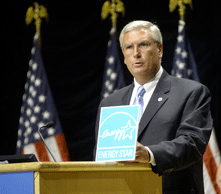
EPA administrator Stephen Johnson says he’d like to change the law so that he could consider the costs of things like the ozone standard. (Photo: EPA)
Dr. Rogene Henderson, a professor at the Lovelace Respiratory Research Institute in New Mexico, leads the EPA’s clean air science advisory committee. That panel of outside experts unanimously recommended a much stronger ozone limit, somewhere between 60 and 70 parts per billion.
HENDERSON: I think he has taken a step in right direction. It’s not as big a step as his advisory committee would have liked. It is discouraging to work very hard and then not have our advice taken.
YOUNG: The EPA analysis says potential health benefits of the limit the panel recommended would be many times greater than the one Johnson chose – more than nine thousand premature deaths could be avoided each year. Henderson says the law requires an adequate margin of safety to protect those most vulnerable to dirty air.
HENDERSON: The main concern, I mean the difference between the level he set and the level we recommended will be that this margin of safety. The sensitive sub-populations such as asthmatics or people with respiratory disease may not be protected at the 75 level.
YOUNG: A separate advisory panel on children’s health reached a similar conclusion, and more than a dozen major public health groups urged Johnson to follow the panel’s advice. But health advocates weren’t the only people weighing in on the ozone decision. Several key lawmakers, including most of the Republicans in the US Senate’s environment committee, told the EPA not to tighten the ozone standard at all. Ohio Republican Senator George Voinovich sent Johnson a letter arguing that the cost to industry would be too great.
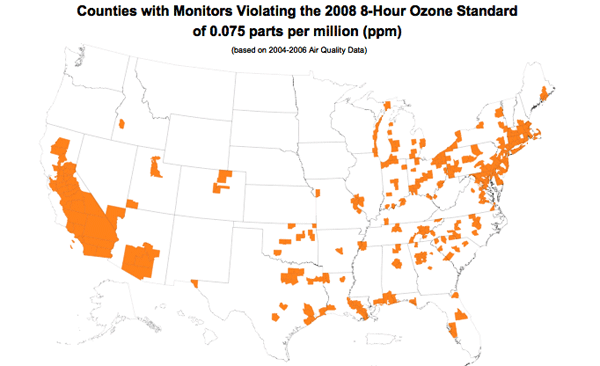
Ozone no-no zones. Live in one of these shaded areas? Then you’ve got air quality problems; levels of ozone in these counties exceed the EPA’s new standard. (Photo: EPA)
YOUNG: EPA and White House records show a parade of lobbyists from manufacturers, the oil and refining industries, chemical companies, automakers and even corn growers made the rounds to argue that a tougher standard would be bad for business. It leads some public health advocates to wonder who really had the most influence over Johnson’s decision. Paul Miller is with NESCAUM, a clean air association that represents northeastern states from New Jersey to Maine, areas with major ozone problems.
MILLER: When you look at the available science, you look at what EPA’s own staff recommended. But EPA picked something higher. Then, yes, I’m left scratching my head wondering – what was the basis for that?
YOUNG: Do you think then that Administrator Johnson listened to those industry lobbyists rather than the scientists?
MILLER: I think it’s very possible that someone in the government listened to those arguments, and either Administrator Johnson was in agreement or was told he was in agreement that the standard would not be set within a range that the science called for and outside experts called for.
YOUNG: It is against the law for the EPA to take the cost of compliance into account when setting a health-based standard for ambient air quality. The U.S. Supreme Court settled that issue in a 2001 decision on the Clean Air Act. Johnson insists he followed that law, and based his ozone decision solely on science. However, he also used the announcement of that standard as a chance to propose major changes to the Clean Air Act. One thing he’d like to change is that ban on considering costs in air quality decisions.
JOHNSON: Bottom line: it’s time to modernize the Clean Air Act to improve human health. It should allow decision-makers to consider benefits, costs, risk tradeoffs and feasibility in making decisions about how to clean the air.
YOUNG: On Capitol Hill there was little interest in Johnson’s proposal to dramatically rewrite one the country’s most important environmental laws. There is, however, a lot of interest in a fuller explanation of Johnson’s ozone decision, and why he ignored his science advisors.
That might clear up how the decision was made, but it will likely be a while before the new standard really clears the air. It could take a decade or more to implement new ozone reductions. And even though ozone levels have declined around the country, many major cities still do not comply with the old ozone standard, set more than 10 years ago.
For Living on Earth, I’m Jeff Young in Washington.
Related links:
- For more information from EPA on the ozone decision, click here
- Read the letter from EPA’s clean air science advisors
- NESCAUM, the clean air network for northeastern states
Ozone's Harsh Harvest
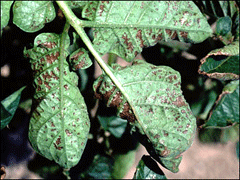
Browning patches on potato leaves shows evidence of exposure to high concentrations of ozone. (Photo: North Carolina State University)
CURWOOD: Ozone is not only bad for the lungs, but it’s also damaging to plants. Ground level ozone turns their leaves brown and spotty, and stunts their growth. It’s particularly noxious to crops. Ozone has already cut cereal production in the U.S. by about five percent, and at the current levels could slash world crop yields nearly 40 percent by the end of the century. Those figures come from John Reilly – he’s associate director of the MIT Joint Program on the Science and Policy of Global Change. He led a recent study on ozone and crops, and joins me now in the studio. Hello, Dr. Reilly.
REILLY: Hello.
CURWOOD: I gather looking at your study that you see ozone pollution as not only a city problem, but a rural problem, and a global one at that.
REILLY: Many years ago when some of the first clean air legislation was passed, I think people thought it was very much as just an urban problem. When measurements have extended, people have realized that the ozone actually lives in the atmosphere for a few months, and so over that time it spreads out across the landscape and in fact, over the course of three months you can have a lot of transport around the entire globe. And so that means that ozone can appear at high levels in different places. The actual ozone levels, then, get higher because the background level is higher.
CURWOOD: Now as I understand it, leaves actually breathe, plants actually breathe. They have these stomata, these openings on their leaves in which they take in air and they let it out. What does ozone do to that process?
REILLY: That’s where the ozone actually enters into the plant. So the plant is trying to use CO2, and that’s one of its basic ingredients that allows it to grow. It’s a little bit like us breathing in, and when we breathe in to get air, that’s when we get ozone damage in our lungs. So it’s kind of a similar process in plants.
CURWOOD: So where there’s a lot of ozone, it’s like us trying to run in heavy traffic?
REILLY: Right. In fact, damage to crops tends to be larger than damage to, you know, other vegetation because we’re usually fertilizing crops, and fertilizing crops is getting them to grow really fast, and it’s like us going out and working really hard, or running really hard. So if you do that and then you have high ozone levels at the time, the damage to crops can be larger than unfertilized vegetation.
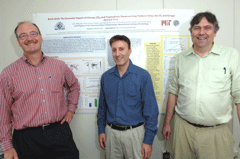
John Reilly (left) and his colleagues Benjamin Felzer (center) and David Kicklighter studied the impacts of increases in temperature, carbon dioxide, and ozone concentrations on global vegetation. (Photo: Donna Coveney, MIT)
REILLY: Well, the increase in CO2 is generally beneficial for plants. But changes in climate are, you know, sometimes good and sometimes bad. You know warming in northern areas tends to kind of increase the growing season and actually increase productivity. A lot of warming in the tropics can actually damage productivity. But ozone is damaging.
So we found that as a result of increasing ozone levels, the combination of these could be as much as a 50 to 60 or 70 percent yield decline in temperate regions in China, the U.S., and Europe. So that was a large net effect on crops, so the ozone effect was dominating there.
CURWOOD: How surprised were you by the results of your study?
REILLY: Well I was, you know, dramatically surprised that the results were so negative, and we checked them several times. There is a threshold, 40 parts per billion of ozone in the atmosphere, above which damage starts occurring. What really happened here is that the actual ozone levels only increased 50 percent, but when measured above this threshold, the amount of ozone increased by six-fold. So that was a dramatic increase and led to this high damage.
CURWOOD: So we’re in a time now when we’re seeing rising prices for food already, I guess in part due to the American dollar not being worth as much as it is and the price of oil going up. And now ozone is another factor to limit crop production?
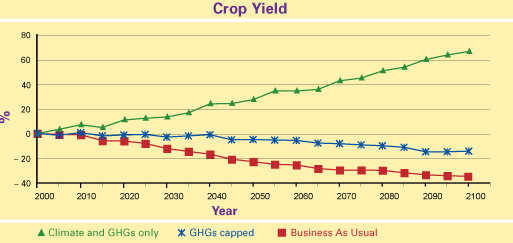
Reilly’s analysis shows that warmer temperatures and increased levels of carbon dioxide in the future could boost crop yields (top curve), but when the effect of rising levels of ground-level OZONE is taken into account, global yields could drop by 40 percent (bottom curve). (Graphic: MIT Energy Initiative)
And then one of the answers to some of these problems are biofuels. And if you had a substantial biofuels program, that would still put more pressure on land resources and food prices.
CURWOOD: What’s to be done?
REILLY: Well, it is possible to select plants that are less sensitive to ozone. But I think one of the key results of this study is this global or hemispheric transport of ozone. So while now individual countries can set standards for their own areas and hope to achieve them, in the future if we don’t control emissions elsewhere, then we will find it difficult to achieve those in our own backyard.
If there is a silver lining to the cloud, it’s that China is also going to experience crop damage from ozone, and it will be very much in their interest to reduce these pollution levels as well.
CURWOOD: John Reilly is associate director of the MIT Joint Program on the Science and Policy of Global Change. Thank you so much, sir.
REILLY: Thank you.
Related links:
- To read John Reilly’s article on ozone and crops, click here
- Learn more about the effects of ozone on plants
- The MIT Joint Program on the Science and Policy of Global Change
[MUSIC: Quicksilver Messenger Service “Fresh Air” from Quicksilver Messenger Service]
CURWOOD: And coming up, a new twist on a diet that cuts the carbs. Keep listening to Living on Earth.
It's a Predator-Eat-Prey World
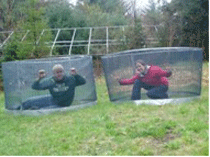
The cages Oswald Schmitz set up for his spiders and grasshoppers are just big enough for humans to lie down in. (Photo: Oswald Schmitz)
[MUSIC: The Bad Plus: “Labyrinth” from Motel (Fresh Sound Records 2000)]
CURWOOD: It’s Living on Earth. I’m Steve Curwood. In the rolling meadows of northeastern Connecticut, it’s a spider-eat-grasshopper world. Over the last 12 years, Yale ecologist Oswald Schmitz has been there, researching the interaction between the predator, the prey, and the ecosystem where they live.
The results of his work have just been published in the journal Science. In the study, Professor Schmitz suggests that the lessons learned in the wire cages that cover just two square meters of meadow in Connecticut can be equally applied to the thousands of acres of wilderness out in the American West.
SCHMITZ: The reason why it’s such a nice experimental system is that to work with bear, and to work with wolves and moose and elk, you’d have to do your studies over, you know, thousands of square miles in range, whereas with these small critters, it’s a nice model system for what the bigger animal systems look like. And you can trace very carefully what all of the creatures are doing in that system, where it’s a lot harder to follow wolves and elk on a landscape. So this experimental system is a nice model system for other kinds of predator-prey interactions in ecosystems.
CURWOOD: So there they are. You have spiders and grasshoppers in these cylindrical cages over a section of grass. What did you find?
SCHMITZ: Well, what’s really interesting is that predators aren’t just predators, in the sense that they have different hunting tactics. And this generalizes to larger mammals also. So there’s one species of spider that roams quite widely all over the vegetation. And then there’s another species of spider that actually sits in one location and ambushes its prey. So one is an active hunter, the other is an ambush predator.
CURWOOD: And then what happens to the plants as a result of those different behaviors?
SCHMITZ: So when the grasshoppers are facing the sit-and-wait ambush predator, they retreat to safer habitat that’s leafy, more complex. So, their preferred food is grasses, and these ambush predators tend to hang out in these grasses – so the spiders retreat to this competitively dominant herb species, goldenrod, which is very common in a lot of these abandoned agricultural fields. It’s a competitive dominant plant that suppresses a lot of the other herbs. And so what happens is the grasshoppers are scared into this herb, and they start eating their refuge too because they still need to meet their daily nutritional requirements. And by lowering the abundance of that, it releases all the other herbs – and so you get a much richer complement of species in the meadow.
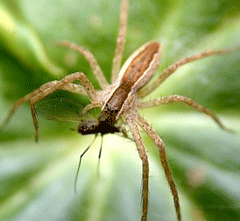
A nursery web spider eats its prey. (Photo: University of Kentucky)
CURWOOD: The ambush type predator, to me it would seem – and I’m not an ecologist – is a harder one to keep in an ecosystem than those that maraud.
SCHMITZ: That’s definitely true because, um, they will seek out places where there’s a really high chance of capturing prey, and so if you’re not supporting that prey base somehow, then those predators will leave or they will go extinct locally. So yes, they’re a harder species to try and keep on a landscape.
CURWOOD: And yet they’re a species that tend to promote more ecological diversity.
SCHMITZ: Indeed, indeed. You know, that’s the important lesson here is, we really, really, really have to think strategically and carefully about protecting these species.
CURWOOD: How can you look at conservation efforts in larger ecosystems, in particular, out West, where there are big ungulates, there are big grazers, you know, elk, they face a pack of wolves, they may face a cougar. How does what you’ve learned affect how people should perhaps be concerned about conservation in areas like this?
SCHMITZ: Okay. You know, wolves tend to do a reasonably good job of capturing and subduing their prey, and so if we don’t want grazers like elk or deer or species like that to become highly abundant and then overgraze the landscape, we need these predators on the landscape to control the prey abundances. For example, in Yellowstone, the wolf is the dominant predator, and elk will shift their range use when facing imminent threat – but then they’ll go back to business as usual and graze out in the prairie. In other parts like Zion, cougars tend to be much more abundant, and the cougars actually change the use of the landscape by elk. And for example, there are riparian areas, riverside areas, that the elk normally graze in – but those are risky in terms of cougar ambushing – and so they end up avoiding those locations, and that ends up rehabilitating stream banks and water quality. So, these lines of dependency we don’t often think about, because we think about the big bad predator and we have to get rid of it. But it’s actually these indirect, counterintuitive beneficial effects that some of these predators actually confer on ecosystems by changing the way they interact with their herbivore prey.
CURWOOD: Oswald Schmitz is a professor of ecology at Yale. Thank you so much, sir.
SCHMITZ: Thank you, Steve.
Related link:
Schmitz Lab
[MUSIC: Sam Barsh “nuTrance” from I Forgot What You Taught Me (RazDaz Records 2008)]
Low-Carbon Diet
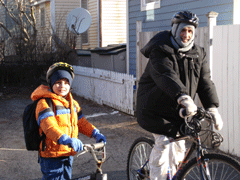
Jason and Miles Taylor set off for school the energy efficient way. (Photo: Helen Palmer)
CURWOOD: There’s no national plan to cut America’s carbon footprint. But some citizens take the issue of reducing greenhouse gas emissions seriously – and throughout the country, there are initiatives to find ways to do just that. Living on Earth’s Helen Palmer reports on some businesses and ordinary people in eastern Massachusetts that are finding practical ways to live a greener lifestyle.
DILOIS: Welcome guys, welcome to Johnny D’s. My name’s Carla DiLois.
[CHEERS; PEOPLE SHOUT GO CARLA, GREEN MARTINIS!]
DILOIS: Anyone who offers a green martin’s is a friend, right?
PALMER: The scene is Johnny D’s, a music club in Davis Square, Somerville Mass. The green martinis are to celebrate local businesses going green. Johnny’s co-owner Carla DiLois:
DILOIS: We’ve done it for a few reasons. One cause it’s saving us a decent amount of money. I’ve calculated we’ve saved about 10 percent so far in the last six months that we’ve done it, of our energy costs. It’s pretty good.
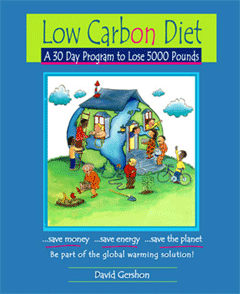
PARK: We’re really excited about that cause they’re made out of corn. We got rid of plastic in that sense, but then we realized that we actually were throwing a lot of cups away rather than what we were able to do before was recycle them, and we were like, this isn’t actually any better cause we’re throwing them away and they’re just going into landfills. So then we sort of started working with a company called Save That Stuff to look at composting and more recycling for our business.
PALMER: Park says overall it saves money – and wins loyalty from staff and customers. That’s part of the idea of Go Green Davis, says Seth Itscan. He owns a couple of web companies in the Square.
ITSCAN: What got this thing going was just sort of the vision of a carbon neutral Davis Square. And the idea that a whole part of a city, a whole business part of a city, could be carbon neutral – that’s obviously a big dream – but I think it’s an achievable dream, and this is the first step of it, is to get the business owners together and to talk about how they can save money while also saving the environment.
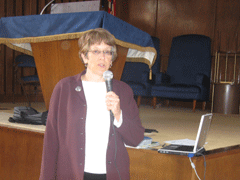
Susan Altman of the Massachusetts Climate Action Network introduces the Low Carbon diet to the congregation at Temple Shalom in Medford.
ALTMAN: It involves people in small groups getting together and helping each other and inspiring each other to do work that might otherwise not get done just because we’re all busy people and it’s very difficult to fit in yet one more little thing.
PALMER: Altman says the Low Carb Diet spreads from friend to friend. It comes with a book full of handy hints – ways to cut your personal carbon footprint by 5000 pounds over 30 days. Many of the ideas are familiar, like replacing those incandescent light bulbs, or remembering to take cloth bags to the grocery store. But Altman says this program works because it gives people a handy way of measuring.
ALTMAN: They march through this book and they write down, by doing this I lost – let’s see, an insulating blanket on your water heater. If you install one, credit yourself with 175 pounds of CO2 reduction annually. So you go through this, and you write down the number of pounds you lose, and every time you do it you get to see, ‘okay, that was 175 pounds, that was 50 pounds that was 450 pounds’ – before you know it you’re at 5000.
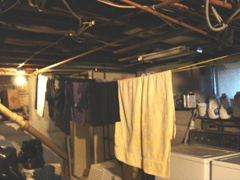
No more electric dryer – the Taylor family hangs the washing on an indoor clothes line. (Photo: Helen Palmer)
RUBIN: I’ve reduced my electricity use by 37 percent, but now I purchase renewable energy, so one could say I’ve reduced it by 100 percent. I’ve reduced my use of heating oil by 40 percent and I’ve reduced my use of gasoline by 71 percent.
PALMER: Rubin’s the director of Green Tourism for Boston. He spoke to a group of folks interested in signing up their friends to try the Low Carbon Diet. He says he made all these savings just by taking the kinds of actions detailed in the Low Carbon Diet book.
RUBIN: There’s no kind of learning that is better than actually making the changes yourself. There’s no kind of learning like figuring out, how do I reduce my own energy bill, and trying different things and seeing your usage go down.
PALMER: And when you see your usage go down, your bills go down, too. That’s a big selling point of the Low Carbon Diet.
PROKOSCH: Okay, so what do you think you spend on gas heat every year?
PALMER: Mike Prokosch is introducing the diet to a group of African-Americans and immigrants at a workshop in a church hall in Dorchester, Massachusetts.
PROKOSCH: Let’s start by looking at some low-cost ways to conserve energy. One of the biggest ways that we’re burning oil or gas is to heat water. How long do people spend in the shower in your household?
[WOMEN ANSWER ‘TOO LONG’; PROKOSCH LAUGHS]
PALMER: Set the kitchen timer and give the kids a five minute time limit in the shower, says Prokosch. Turn the thermostat down. Save energy by doing laundry in cold water.
[WOMAN SAYS ‘WE DO JUST ABOUT ALL OUR CLOTHES IN COLD WATER’; PEOPLE DISCUSS CLOTHES WASHING HABITS]
PALMER: The diet’s a hit with Cynthia Jarvis. She’s a single mother who’s originally from Antigua and works as a health aide.
JARVIS: This workshop is very interesting and you learn how to save energy and all them good stuff just to save some money in your pockets.
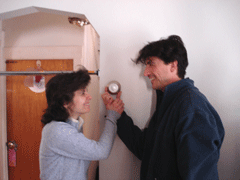
The thermostat wars - Jason Taylor and his wife Michelle Makarian. (Photo: Helen Palmer)
[DOORBELL; DOOR OPENING AND CLOSING]
WOMAN: Who is it?
PALMER: It’s Helen
MAN: Hi…
PALMER: One of my neighbors in Cambridge, contractor Jason Taylor, started the Low Carb Diet a couple of months ago.
TAYLOR: I’ve become a crazed thermostat watcher. And we’re in a constant battle, my wife and I – I turn it down, she turns it up – but still, I’m gaining on her.
PALMER: Jason says they wear sweaters, and they bought a new energy star refrigerator.
TAYLOR: If you want to come into my basement, I can show you we had… When we moved in here, there was already this clothes line – it was a clothes line, an indoor clothes line, and as you can see we use the…because apparently the biggest use of electricity is when you have an electric clothes drier. So long underwear is my other uh…I’ve got five pairs of long underwear now.
PALMER: Jason’s signed up his son, eight-year-old Miles, as well.
TAYLOR: Miles, how often do I take you to school on the bike?
MILES: Well we usually take the bike every day except when, like, it’s really, really icy or snowy.
TAYLOR: Right. You want to tell her about the re-charger, the battery re-charger we have?
MILES: Oh yeah, we have a solar battery re-charger out there.
TAYLOR: It’s really cool.
MILES: Yeah.
PALMER: Jason reckons he’s saved over 6,600 pounds of carbon so far. Susan Altman of the Massachusetts Climate Action Network says, over the last six months, thanks to the diet, the Bay State as a whole has cut its carbon dioxide emissions by about 305,000 pounds. It’s not much, compared with the 48 tons of CO2 that US coal-fired power plants emit every year – but more teams are signing on to go Low Carb every week, and every little bit helps.
For Living on Earth, I’m Helen Palmer in Cambridge.
CURWOOD: You too can get ahold of the Low Carbon Diet book, and find tips on how to lose 5,000 pounds in just 30 days. Details are on our website – L-O-E dot org.
Related links:
- Massachusetts Climate Action Network
- Low Carbon Diet Book
Broken Bulb Dreams

Mercury is a key ingredient in fluorescent light bulbs and has negative environmental and health effects. (Photo: Environmental Protection Agency)
CURWOOD: Now, one of the easiest carbon-cutting ideas is to swap out incandescent light bulbs and replace them with compact fluorescent bulbs. Compact fluorescents have been touted as the Great Light Hope, but there are problems with these bulbs: they contain a small amount of toxic mercury. A broken bulb can emit vapors that may be dangerous to a person’s health, and disposal is a problem. With me now to shine, well, a light on this subject is Urvashi Rangan. She’s a senior scientist and policy analyst with Consumer’s Union. Dr. Rangan, welcome back to Living on Earth.
RANGAN: Thank you so much, Steve.
CURWOOD: Dr. Rangan, there are a couple of studies, I think one done by the state of Maine and another from the Mercury Policy Project based in Vermont, that have issued some reports on the risks of mercury poisoning to infants, children, and pregnant women if compact fluorescent bulbs break. What are the findings of those reports?
RANGAN: In those reports they reported on a series of experiments that they did where they broke compact fluorescent bulbs in a small or moderate sized room, and then they conducted various clean-up techniques. And then they tested the air at various height levels that would represent either an infant walking around, or a toddler, or an adult. So they looked at one foot and five feet in terms of the height differential and the amount of mercury that was found at those different height levels.
CURWOOD: And if you’re at the lower level, you’re in a lot more trouble I gather.
RANGAN: It definitely seemed to be the case that at the one foot level, you had a lot more mercury cloud aerosolized, and so that’s why the danger to infants and toddlers was flagged in this case.
CURWOOD: So wait a second – I have a compact fluorescent bulb, I drop it, I break it on the carpet in my living room, and suddenly I have a major health hazard?
RANGAN: You actually have a small hazard going on. And the trick to cleaning this is actually to get rid of the spot where the compact fluorescent bulb landed – that is, if it’s rug – and the best advice for getting rid of it is to cut that piece of rug out, or if it’s an area rug, to get it out of the room. That’s the most surefire way of making sure that you get the mercury out of your room.
CURWOOD: Now, details on the clean-up procedures will be on our website. But what are consumers supposed to do here, Urvashi?

Urvashi Rangan is senior scientist and policy analyst with Consumers Union. She warns green-minded consumers to be aware of risks that come with fluorescent light bulbs. (Photo: Consumers Union)
CURWOOD: So what am I supposed to do when my compact fluorescent light bulb quits working, you know flickers one last time?
RANGAN: Well in some states they actually require you to recycle them, and there’s a variety of different options. Sometimes there’s a curbside pick-up, where things like your lithium batteries, old cans of paint, other household hazardous waste would go, and that’s where your compact fluorescents would go as well. Alternatively, some states may have drop-off locations, or they may have collection days a couple days a year.
CURWOOD: What about retailers, the people that sold me these bulbs? What about having them take them back?
RANGAN: There are some retailers like IKEA that have stepped up to the plate and offer a take-back center for these bulbs, and that’s really I think noble on behalf of the retailers to be offering these things. But convenience is often a factor in how effective recycling can be, and if it’s not convenient, products are often not recycled.
CURWOOD: Now, why do compact fluorescent bulbs have mercury in them in the first place?
RANGAN: It’s actually part of the technology to light those bulbs. You need mercury vapor. And so one has to really ask, while there’s been a lot of hype and focus on the energy efficiency of compact fluorescents and fluorescent lighting in general, is it really the overall sustainable solution? Compact fluorescents are more energy efficient, I mean no one can argue with that, but there are other technologies, like LED technology, that are really offering even less toxic, as energy efficient alternatives. And I think that compact fluorescents may just be a stop along the way in terms of finding the most sustainable solution.
And we also have to look at how these things need to be disposed, how are they produced, how much energy goes into all of that, and how much energy goes into recycling these things once they’re done. So all of those things also need to be taken into account when we’re looking at overall sustainability.
CURWOOD: Urvashi Rangan is a senior scientist and policy analyst with Consumer’s Union. Thanks for taking the time, Urvashi.
RANGAN: Steve, thanks so much.
Related links:
- Consumers Union
- To read the report “Shedding Light on Mercury Risks from CFL Breakage,” click here
- Maine DEP lamp breakage study and revised cleanup guide
[MUSIC: Sam Barsh “George Dub” from I Forgot What You Taught me (RazDaz Records 2008)]
CURWOOD: Just ahead – Help! We’re being invaded by smelly plants! Could weevils save us? Stay tuned to Living on Earth.
ANNOUNCER: Support for the Environmental Health Desk at Living on Earth comes from the Cedar Tree Foundation. Support also comes from the Richard and Rhoda Goldman Fund for coverage of population and the environment. This is Living on Earth on PRI: Public Radio International.
Emerging Science Note/Bees
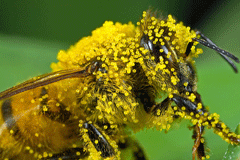
Honeybee covered in pumpkin pollen. (Photo: John Kimbler)
CURWOOD: It’s Living on Earth. I’m Steve Curwood. Coming up: non-native plants threaten to take over. But first this Note on Emerging Science from Annie Jia.
[Sweet Inspiration music]
JIA: Bees give us many things. Honey, stings – even inspiration for Hollywood B movies. But a better internet? That’s what one group of scientists is devising, thanks to these busy workers—or rather, dancers.
[Science note music]
When bees find new honey, they dance. Their jigging, however, is not for celebrating – it’s to tell their hivemates about the discovery. Bees use boogying to communicate the quality of each flower patch, and with this knowledge they fluidly shift their workforce as nectar supplies change.
Researchers at the Georgia Institute of Technology realized the internet faces a similar challenge as bees. A limited number of web servers provide processing power to many websites, whose traffic constantly changes – just like a limited number of bees collect nectar from many flower patches.
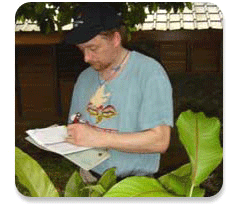
Professor Craig Tovey’s observations of field bees provide clues of better ways to organize server space on the Net. (Photo: Georgia Institute of Technology)
Another upgrade, inspired by bees that stay home on cloudy days when flowers aren’t blooming, would turn off the power to idle servers. This could cut energy use by 20%.
Staying home? Dancing? Sweeeeeet.
That’s this week’s note on emerging science. I’m Annie Jia.
Related link:
Center for Biologically Inspired Design at the Georgia Institute of Technology
Garlic Mustard Raises a Stink
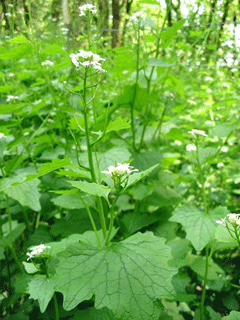
It may look harmless, but garlic mustard is wreaking havoc on ecosystems across the country. (Photo: Glenn Miller, Oregon Department of Agriculture)
CURWOOD: In the kitchen, garlic and mustard are favorite ingredients to flavor and spice our food. But the garlic mustard plant – well, that’s more like a stinky kettle of fish. This unwelcome import from Europe has taken over millions of acres of forest floors in America and is far too widespread to get rid of easily. So, scientists are now looking to biological control to address the garlic mustard problem. Joining me now is Adam Davis. He’s an ecologist with the Agricultural Research Service of the USDA, and teaches at the University of Illinois. Hello, Professor Davis!
DAVIS: Hello.
CURWOOD: Tell me about the garlic mustard plant.
DAVIS: Garlic mustard is a biennial plant, which means it takes two years to complete its life cycle. It’s home range is in Europe, extending into Western Asia. It’s a very hardy plant; it comes out pretty much first thing at the end of winter, beginning of spring, and dominates the forest floor.
CURWOOD: Just how, when, and where was it introduced to North America?
DAVIS: It was actually brought in intentionally – 1869 – it was brought in as a culinary herb in Long Island. But unfortunately it doesn’t taste very good, like a really sharp mustard green.
CURWOOD: Since it came, it’s what, in 34 states and 4 Canadian provinces? And it just keeps on going.
DAVIS: Ya. Well it does best within temperate forests in kind of the northern part of the U.S. But it’s getting more and more prevalent within each of the states where it’s found.
CURWOOD: This plant is considered a pest. Why is it so unstoppable?
DAVIS: It seems to have a few different mechanisms that make it particularly invasive. It’s cold-hardy and shade tolerant, so comes up early in the spring when most plants aren’t able to grow. It also appears to secrete what are called allelochemicals into the soil. Allelochemicals are chemical compounds that one plant introduces into the growing environment to suppress the growth of another plant. So it’s kind of chemical warfare against the native plants.
CURWOOD: Now typically with a week, a plant you don’t want, you just pull it up and you get rid of it. What about the garlic mustard?
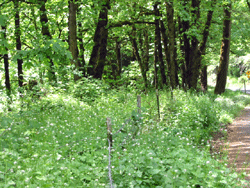
On the frontlines of a garlic mustard invasion. (Photo: Glenn Miller, Oregon Department of Agriculture)
CURWOOD: As I understand it, some researchers in Switzerland have discovered a predator that has a particular taste for garlic mustard.
DAVIS: Yeah, this predator is called Ceutorhynchus scrobicollis, and these weevils are very well adapted for dealing with garlic mustard. Garlic mustard has some potent antifeedant compounds that it produces, and in order to eat garlic mustard these weevils have to detoxify it.
CURWOOD: I gather there’s some pressure to bring this weevil in and sic it on plants, but of course when one does that, there could be unintended consequences.
DAVIS: Sure. In recent years biological control has received some negative press because of the unintended consequences. And as a new generation of biocontrol specialists, we’re trying to develop ways of minimizing risk to non-target species.
CURWOOD: I understand you use computer modeling to assess using this weevil to control the garlic mustard plant. How did that work out?
DAVIS: It worked out quite well. We simulated transitions between different garlic mustard life stages and across different parts of its range and tried to figure out how much damage and what types of damage would be necessary to control garlic mustard.
CURWOOD: And the computer told you what?
DAVIS: The computer told us this particular weevil is very very specific. It’s monophagous – it just eats garlic mustard.
CURWOOD: What about the ability of this weevil to adapt? If it figured out how to eat garlic mustard, maybe it could figure out how to eat chrysanthemums, something like that.
DAVIS: This weevil coevolved with garlic mustard over millenia, and so if it burns itself out in a local population, it’s just not going to have the time to adapt.
CURWOOD: What would be a successful outcome?
DAVIS: I think completely eradicating it is really unlikely. But the goal of classical biological control is to have the agent and the plant pest come to some new sort of equilibrium at a much lower population density.
CURWOOD: I imagine people listening to us are going to feel somewhat apprehensive despite your assurances it’s very low probability – and the problem is this – typically we don’t know what we don’t know, we just don’t know what the weevil might try to do to adapt in response.
DAVIS: One of the suggestions for further reducing risk associated with biological control is to do preliminary caged releases, where you could see if the agent starts behaving differently in the introduced range than in the home range. It’s not really about eliminating risk, it’s about managing risk and thinking more in a risk-benefit framework.
CURWOOD: Adam Davis is a plant ecologist with the agricultural research service of the USDA and teaches at the University of Illinois at Champaign-Urbana. Thank you so much.
DAVIS: Thanks for having me.
Related link:
National Invasive Species Information Center
Invasion of the Invasives
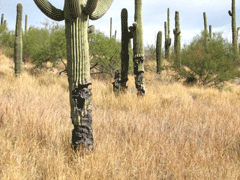
Invasive buffelgrass burns easily- and damages the native Saguaro cacti. (Photo: Jim Williams)
CURWOOD: The Sonoran Desert runs from northwest Mexico up into the southwest U.S., and covers most of southern Arizona and the southeast corner of California. It’s a starkly beautiful landscape, full of unique animals, an array of colorful birds and bizarre and hardy plants. It’s signature species is the giant saguaro cactus, which towers over the pebbly desert soil like a huge scarecrow, its outstretched arms up to ten feet off the ground.
But a new threat is springing up at the feet of these desert sentinels. Non-native grasses are spreading rapidly, and bringing with them the danger of wildfires. Jim Williams of KUNM visited Saguaro National Park near Tucson, Arizona, where one troublesome invasive has caught everyone’s attention.
NATS: [Hacking at buffelgrass, pulling, grunting.]
JOHNSON: You give it a, sometimes a good twist here, kinda like a rope it holds it together better. They get down in the crevices, which makes it a little more creative to get ‘em out.
WILLIAMS: On an afternoon that would be called hot by most anyone not from Arizona, Matt Johnson hacks away with a steel pick on a rocky slope in Saguaro National Park. He’s one of eight volunteers from the Arizona Native Plant Society who are pulling a stubborn non-native plant called buffelgrass.
GRAFFAM: Incredible.
WILLIAMS: Clint Graffam says he can’t believe how fast this Sonoran desert’s filling up with these wheat-colored clumps.
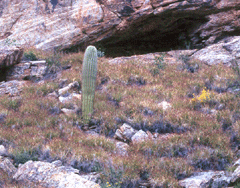
Buffelgrass plants surrounding a young saguaro cactus, Saguaro National Park, Arizona. (Photo by Todd Esque, USGS)
WILLIAMS: Buffelgrass is from Ethiopia, where it was named after the buffalo who loved it. The U.S. government imported it in 1938 and planted it in trial plots for use as cattle food and to reduce soil erosion in the American Southwest. Back then, it had a difficult time getting established. But fast-forward about seventy years, and it’s now found its way to roadsides in Tucson, and within the past few years it’s spread like, well, wildfire, up into the desert and onto its surrounding hillsides. Some scientists believe global warming could be fueling the spread: Tucson’s in a multi-year drought, and average summer temperatures have been increasing. Whatever the reason, though, buffelgrass loves it here now. And while the sight of it is troubling, botanists and ecologists are most worried about the fire it will inevitably bring. The grass, which is tinder-dry and dormant for most of the year, burns quickly and at very high temperatures. Matt Johnson has just cleared a skirt of bufflegrass from around the base of a massive saguaro.
JOHNSON: This saguaro will not now burn if a fire were to come start tomorrow in this remaining patch of grass, and kinda like people, saguaros, if they get more than about sixty percent of their stem surface burned, same as severe burn victims, the survival rate goes way down. Just a little singeing around the base they’ll handle, but, Whew! [Laughs.]
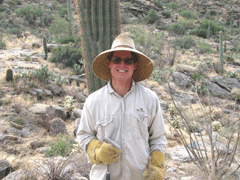
Volunteer Matt Johnson holds a clump of buffelgrass. (Photo: Jim Williams)
HANSEN: There are a lot of homeowners in the foothills and such that have major infestations of this grass. I don’t know how aware they are, but this poses a real threat to their property as well. This grass burns very vigorously with very tall flame. And it’s easily able to destroy a house, and all the plants, including saguaros, around it.
BETANCOURT: It is the plant from hell.
WILLIAMS: Julio Betancourt is a senior scientist with the U-S Geological Survey. In recent years, he’s been all over the media around the world talking about buffelgrass. Betancourt stands and points up at the southern base of the Catalina Mountains, which rise out of what’s quickly becoming north Tucson.
BETANCOURT: And you can see all these patches, like do you see that patch right down there, that’s buffelgrass right there. Do you see that patch over there next to Pima Canyon? Buffelgrass. When you start looking down the mountain you start picking out all these little patches. And that’s all buffelgrass, and eventually, the whole ridge will be buffelgrass.
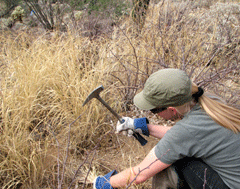
Pima Community College student Shelly Lyons digs up buffelgrass as part of her biology class service learning project. (Photo: Jim Williams)
BETANCOURT: I think humans have this animalistic visceral reaction to changes on the landscape. And I think the same thing is already happening with the population in Tucson, that they notice something is changing, and changing very, very fast.
WILLIAMS: Well, the Park Service has noticed, that’s for sure. It’s partnered with the Arizona Native Plant Society and a relentless group named the Sonoran Desert Weed Wackers to build an impressive team of buffelgrass-tackling volunteers. But it’s a foot race the grass seems to be winning. Meg Weesner is Saguaro National Park’s chief of Science and Resources Management. She says researchers are seeing native plants like the green-trunked paloverde and saguaro dying out in stands of buffelgrass, their water supply cut off by the invaders. Southern California has seen invasive grasses take over in similar ways in recent years. Weesner says think of the fires there as exactly what could happen in Tucson and Saguaro National Park.
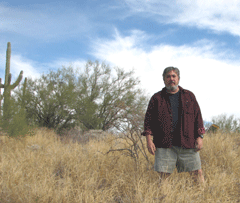
USGS Senior Scientist Julio Betancourt in a field of buffelgrass. (Photo: Jim Williams)
WILLIAMS: That process kills the native Sonoran plants, turning the desert into an African savanna, a grassland. In places in northern Mexico, that’s already happened. And it’s an expensive problem. Buffelgrass has now spread into a thousand acres of Saguaro National Park. Without the help of volunteers, removing the buffelgrass can cost over $13,000 dollars an acre. Weesner says the park service has also begun herbicide spraying on the grass because digging it up can actually spread the seeds. But spraying costs $1200 dollars an acre. And because the chemical has to be absorbed by the plant, the buffelgrass can only be sprayed when it’s green, which means a very short window of opportunity in the summer. Add to that the fact that the chemical is essentially a version of Roundup, which some studies have shown might harm soil bacteria and amphibians. But the volunteers out on the hillside in the park say fire is a much more immediate and devastating threat. Meg Weesner says all the challenges require a huge collective effort.
WEESNER: The park has partnered with almost everybody who manages a plot of large ground in the Tucson basin. We have all of the land managing agencies, all the departments of transportation, and we actually had a summit last winter to develop a coordinated effort, because it doesn’t help to get rid of the grass on one side of the fence if it’s on the other.
WILLIAMS: And with a lack of federal funding to deal proactively with invasives, Weesner says the Park Service is struggling to stay on top of it all. But she adds that, with the battalion of volunteers, the city of Tucson and Pima County all in on the buffelgrass fight, she’s hopeful.
WEESNER: You have to be an optimist in this field. [Laughs.] It’s the only way to be.
NATS: [hacking, pulling, and grunting sounds]
WILLIAMS: Back in the buffelgrass-choked Saguaro National Park, volunteer Matt Johnson keeps swinging his pick.
JOHNSON: It’s job security, I guess. [Laughs.] [hacking, pulling and grunting sounds]
WILLIAMS: For Living on Earth, I’m Jim Williams, in Saguaro National Park.
Related links:
- Saguaro National Park
- Arizona Buffelgrass activities and information
CURWOOD: You can get our program any time on our website or get a download for your MP3 player. The address is L-O-E dot org. That’s loe dot org. You can email us at comments at L-O-E dot org, once again, comments at l-o-e dot org. Our postal address, 20 Holland Street Somerville, Massachusetts 02144. And you can call our listener line at 800 218 9988. That’s 800 218 9988.
[MUSIC: Ennio Morricone “The Good The Bad The Ugly” from Film Music Maestro (Mbopglobal BCD 2004)]
CURWOOD: On the next Living on Earth, outdoor wood boilers may be an inexpensive way to heat your home, but in Maine, they’re making enemies out of neighbors.
MAN: People are not allowed to dump poison waste on my property. They’re not allowed to poison the water that we drink. But meanwhile they’re contaminating and poisoning the air that we breathe. That shouldn’t be allowed.
CURWOOD: The boilers that generate heat and controversy, next time on Living on Earth.
[EARTH EAR: Various “Red Rumped Parakeet” from 50 Birds Songs From Around The World (Special Music Company 1994)]
CURWOOD: We leave you this week down under…
[EARTH EAR: Various “Red Rumped Parakeet” from 50 Birds Songs From Around The World (Special Music Company 1994)]
CURWOOD: …in southeast Australia, with the Red-Rumped Parakeet. These colorful birds are natives of this region, but now have to compete with starlings and sparrows for nesting sites. So humans often help them along by providing nest boxes. The parakeet’s melodious tunes were recorded for the compilation CD, “50 Bird Songs From Around the World.”
[EARTH EAR: Various “Red Rumped Parakeet” from 50 Birds Songs From Around The World (Special Music Company 1994)]
CURWOOD: Living on Earth is produced by the World Media Foundation. Our crew includes Ashley Ahearn, Bobby Bascomb, Eileen Bolinsky, Bruce Gellerman, Ingrid Lobet, Helen Palmer, Mitra Taj and Jeff Young, with help from Jennifer Baessler, Sarah Calkins and Jackson Braider. Our interns are Annie Jia and Margaret Rossano. Thanks, this week, to the National Parks Conservation Association. Jeff Turton is our technical director. Alison Lirish Dean composed our themes. You can find us at LOE dot org. I’m Steve Curwood. Thanks for listening.
ANNOUNCER1: Funding for Living on Earth comes from the National Science Foundation, supporting coverage of emerging science and Stonyfield Farm, organic yogurt and smoothies. Stonyfield Farm pays its farmers not to use organic growth hormones on their cows. Details at Stonyfield.com. Support also comes from you our listeners, the Ford Foundation, the Town Creek Foundation, the Oak Foundation, supporting coverage of climate change and marine issues, and Pax World Mutual Funds, socially and environmentally sustainable investing. Pax World: for tomorrow. On the web at paxworld.com.
ANNOUNCER2: PRI, Public Radio International.
Living on Earth wants to hear from you!
Living on Earth
62 Calef Highway, Suite 212
Lee, NH 03861
Telephone: 617-287-4121
E-mail: comments@loe.org
Newsletter [Click here]
Donate to Living on Earth!
Living on Earth is an independent media program and relies entirely on contributions from listeners and institutions supporting public service. Please donate now to preserve an independent environmental voice.
NewsletterLiving on Earth offers a weekly delivery of the show's rundown to your mailbox. Sign up for our newsletter today!
 Sailors For The Sea: Be the change you want to sea.
Sailors For The Sea: Be the change you want to sea.
 The Grantham Foundation for the Protection of the Environment: Committed to protecting and improving the health of the global environment.
The Grantham Foundation for the Protection of the Environment: Committed to protecting and improving the health of the global environment.
 Contribute to Living on Earth and receive, as our gift to you, an archival print of one of Mark Seth Lender's extraordinary wildlife photographs. Follow the link to see Mark's current collection of photographs.
Contribute to Living on Earth and receive, as our gift to you, an archival print of one of Mark Seth Lender's extraordinary wildlife photographs. Follow the link to see Mark's current collection of photographs.
 Buy a signed copy of Mark Seth Lender's book Smeagull the Seagull & support Living on Earth
Buy a signed copy of Mark Seth Lender's book Smeagull the Seagull & support Living on Earth

